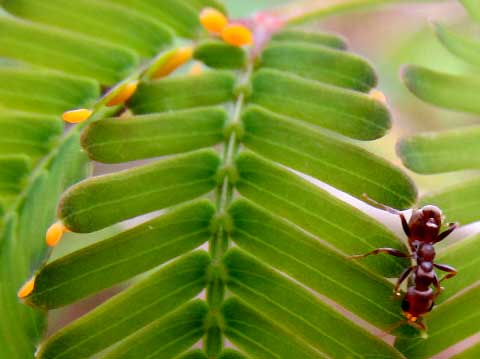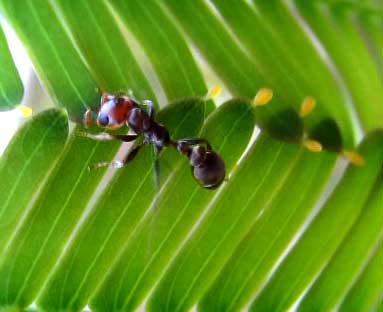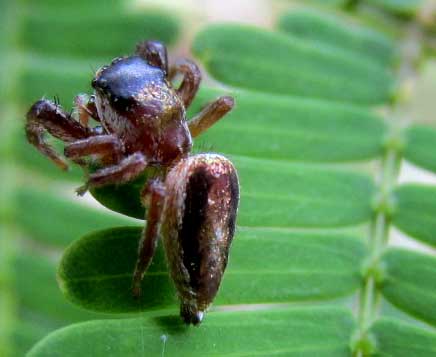Excerpts from Jim Conrad's
Naturalist Newsletter
![Bull-Horn Acacia, VACHELLIA [ACACIA] COLLINSII](../n/10/100328ac.jpg)
from the March 28, 2010 Newsletter issued from Hacienda Chichen Resort beside Chichén Itzá Ruins, central Yucatán, MÉXICO; limestone bedrock, elevation ~39m (~128ft), ~N20.676°, ~W88.569°
BULL-HORN ACACIA & ITS ANTS
On a forest trail I almost stepped on something that would have lamed me if I'd been barefooted. It was a twig section from the tree above me, the tree shown above. This is one of a couple of Bull-Horn Acacias we have here, probably VACHELLIA [ACACIA] COLLINSII, Subín in Maya, now in the dry season nearly completely leafless. Earlier our acacias were place in the genus Acacia but now the trend seems to be to place them in Vachellia A close-up of some thorns shows what's bull-hornish about them below:
![Bull-Horn Acacia, VACHELLIA [ACACIA] COLLINSII, thorns with ant holes](../n/10/100328ad.jpg)
In that picture notice that two of the 2-¾ inch (4 cm) spines bear holes near their tips. Ants chew these holes, enter the hollow thorns and live inside. A single ant colony may span several V. collinsii trees. If a herbivore comes along and touches the tree, the ants rush onto the animal and bite. Thus it's a mutualistic relationship, with both tree and ant benefiting.
The tree not only provides handy shelters for the ants but also feeds them. Take a look at the expanding leaf below:
![Bull-Horn Acacia, VACHELLIA [ACACIA] COLLINSII, Beltian bodies & glands for ants](acaciabb.jpg)
Acacia leaves are bipinnate -- twice compound -- so the entire feathery, purplish, ant-mounted structure in the picture's lower right corner is a leaf about to expand. At the top, left of the leaf the shoehorn-like thing with two green-doughnut-like items in the horn is the leaf's stem, or petiole, and the green doughnuts within petiole's concavity are glands producing sweet, energy-rich nectar the ants feed on. Notice that many but not all the leaves' ultimate leaflets bear teardrop-shaped, dark purple, shiny things. Those are Beltian bodies, which are protein- rich structures eaten by the ants as well. Once the leaves are fully expanded, the Beltian bodies will have been eaten and there won't be a sign left of them.
The Bull's-Horn Acacia above me that day was practically leafless, but nearby grew a shoulder-high sapling. Saplings often bear leaves even when larger trees of their species don't.
from the March 19, 2017 Newsletter issued from Rancho Regensis north of Valladolid, Yucatán, MÉXICO;
elevation ~40m (~130 ft), N~20.876°, W~88.170°
BULLHORN ACACIA FLOWERING & FRUITING
A fellow in Velbert, Germany specializing in ants wrote asking for Vachellia collinsii seeds so he could grow trees in which acacia-thorn ants live. Weeks ago I found some bullhorns here on the ranch and have been waiting for the fruits to mature. This week they're maturing and if you look hard -- they're camouflaged to look like spines -- below you can see the dark, pod-like fruits with pointy tips among more slender, sharper-tipped spines
![Bull-Horn Acacia, VACHELLIA [ACACIA] COLLINSII, fruits among spines](../n/17/170319ac.jpg)
Below and up close you can see some pods, two of which have split open and lost their contents
![Bull-Horn Acacia, VACHELLIA [ACACIA] COLLINSII, open fruit capsules](../n/17/170319ad.jpg)
Two split-open pods with their contents in place -- the pods matured in a cup in the hut -- are shown below:
![Bull-Horn Acacia, VACHELLIA [ACACIA] COLLINSII, open fruits showing seeds amid pulp](../n/17/170319ac.jpg)
I was surprised that the black seeds (beans) developed with such a large amount of greenish pulp between them. I'm interpreting this to be an adaptation encouraging animals to eat the pulp, in the process swallowing the seeds, which later will be disseminated away from the parent tree in the animal's feces.
Both here and around Chichén Itzá mature Bullhorn Acacias not only are protected by their spines and biting ants living in those spines, but also by wasps who build paper nests on the trees' limbs, as shown below on a flowering branch:
![Papwer wasp nest on Bull-Horn Acacia, VACHELLIA [ACACIA] COLLINSII](../n/17/170319af.jpg)
The wasps in those nests do sting with the slightest provocation. As I photographed a spine with an ant entry hole I was stung twice on the back of the head. Interestingly, first the camera and my fingers were attacked, and then the top of my bald head, but no sting resulted. Then they found the hair at the back of my head and the stinging began. Maybe the wasps needed hairs for holding onto as they drove their stingers into me. Two stings caused considerable swelling that lasted several hours. The spine with an ant hole for which I paid with the stings is shown
![Bull-Horn Acacia, VACHELLIA [ACACIA] COLLINSII, spine with ant hole](../n/17/170319ag.jpg)
We've already seen the Bullhorn's tiny, yellowish packages of protein called Beltian bodies, which grow at the tips of young leaflets. Ants eat the bodies. This week I got an even nicer picture of the bodies, shown below:
![Beltian bodies on Bull-Horn Acacia, VACHELLIA [ACACIA] COLLINSII](../n/17/170319ah.jpg)
from the March 27, 2016 Newsletter issued from Hacienda Chichen Resort beside Chichén Itzá Ruins, central Yucatán MÉXICO
VEGETARIAN SPIDER ON BULLHORN ACACIA
The BBC is working on a documentary film about the Yucatan and for some time one of their researchers, Alec, has been writing to me for background information. The other day Alec mentioned that he'd like to incorporate footage of a "vegetarian spider," Bagheera kiplingi, a Neotropical jumping spider occurring from the Yucatan south to Costa Rica. I'd never heard of the spider, but learned all about it in a paper by Christopher Meehan and others, entitled "Herbivory in a spider through exploitation of an ant-plant mutualism," in a 2009 issue of Current Biology. The paper can be downloaded from http://www.sciencedirect.com/science/article/pii/S0960982209016261
In our area the spider occurs on the Bull-horn Acacia, Vachellia [Acacia] collinsii. We've seen that that tree is home to biting ants and yellow "Beltian bodies" at the tips of young leaflets, the Beltian bodies being rich in protein, and providing food for the ants. All this has been known for a long time. What's new is the "vegetarian spider" who also feeds on Beltian bodies instead of killing prey. Meehan and his group describe their paper as ".. the first report of a spider that feeds primarily and deliberately on plants."
Upon reading the above article I went to see who might be roaming the leaves of Bull-horn Acacias near the hut. Normally our Bull-horns are leafless at this time of year, but during the last month we've enjoyed three puddle-making rains, so things have greened up surprisingly. I mention this because I've seen Beltian bodies only on newly emerging leaves after good rains. Maybe after our recent rains the Bull-horns would bear some new leaves with Beltian bodies.
The first Bull-horn Acacia I checked bore no new leaves or Beltian bodies, and only a few ants wandered among thorns and few remaining older leaves. The second tree, however, in a shadier environment and with the ground around it covered with moisture-conserving leaf litter, was indeed producing a few new leaves, and the leaflets bore tiny, egg-shaped, orangish-yellow Beltian bodies. Moreover, hundreds of ants swarmed all over the tree, and some were harvesting Beltian bodies, as you can see below:

Meehan's paper says that in the Yucatan the ant species his group had seen harvesting Beltian bodies was Pseudomyrmex peperi, so I assume that that's what we're seeing in the picture. To help with identification, a side view of an ant scurrying away carrying a Beltian body is shown below:

I had hardly hoped to find the "vegetarian spider," Bagheera kiplingi, but lo and behold a jumping spider turned up on a leaf right before my face, shown below:

Was this the vegetarian? Later I'd see that it was similarly structured but differently colored from those in pictures of the species on the Internet, though it almost matched some pictures. The species is known to be variable so I'm thinking that this is indeed the "vegetarian spider," Bagheera kiplingi, though I can't be for sure.
Meehan's paper says that the diet of spiders studied in the Yucatan consisted of about 91% Beltian bodies, though in Costa Rica only about 60%. They supplemented Beltian bodies with nectar from glands at the base of acacia leaves, plus they occasionally abandoned their vegetarianism and preyed on larvae of the acacia ants, as well as small, nectar-feeding flies, and (rarely) other "vegetarian spiders" smaller than themselves. On a second visit to the tree I didn't see the spider in our photo, but there was another jumping spider, much smaller and pale yellow, which I thought might be an immature "vegetarian spider."
It's hard for me to envision the spiders preying on the ants' larvae because the spider I watched spent a lot of time avoiding the ants. I didn't see the spider feed on Beltian bodies, or even get close to the smaller, ant-infested leaves bearing the bodies.
One final note about this amazing spiny-acacia/ Beltian-body/ ant/ spider relationship is that, at least in our area, yet another species seems to be involved. Every Bull-horn Acacia I've seen lately bears at least one melon-sized paper-wasp nest, the wasps obviously choosing the acacia's spiny branches over non-spiny ones.
I guess that the benefit to the wasp is that small animals are less likely to climb a spiny, ant-infested tree to feed on the wasps' larvae. However, what about the larva-eating disposition of the "vegetarian spider," and possibly of the acacia ants themselves? We've documented marauding army ants robbing a paper-wasp nest of its larvae, at www.backyardnature.net/yucatan/ant-wasp.htm
Meehan and his group have described a very interesting web of relationships centering around the Bull-horn Acacia, but maybe the web is even more intricate and surprising than his paper documents.
issued on March 16, 2020 from Tepakán, Yucatán MÉXICO
BIRDS FEEDING ON FRUIT PULP
During these hot, dry days with stiff breezes, the Bull-horn's hard legumes are cracking open, revealing greenish pulp in which small beans are embedded, and birds come to feed. The first to arrive in the trees next to the stone hut are the Plain Chachalacas, one of which is shown below, the front half of the bird's body entering from the left, the neck curving so that the head comes up from below an open fruit:
![Plain Chachalaca feeding on open legumes of Bull-Horn Acacia, VACHELLIA [ACACIA] COLLINSII](../n/20/200316b1.jpg)
Probably the most frequent visitors are the Altamira Orioles, as shown below:
![Altamira Oriole feeding on open legumes of Bull-Horn Acacia, VACHELLIA [ACACIA] COLLINSII](../n/20/200316b2.jpg)
Another regular visitor is the Black Catbird.